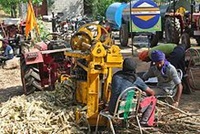Slowdown will see 12 million in India shifting to farms: Crisil
08 Jan 2014
An extended slow-down of the economy combined with a drop in labour intensity across industry and services will cause a decline in non-farm employment by more than 25 per cent to 38 million in FY 2013-19, from levels around 52 million seen in FY 2005-12, pushing back nearly 12 million people to farm jobs in the process, Crisil Research said in a study released on Tuesday.
 The study estimates that fewer jobs are being created with the economy treading a lower-growth path and labour intensity is declining across industry and services.
The study estimates that fewer jobs are being created with the economy treading a lower-growth path and labour intensity is declining across industry and services.
As a consequence, an additional 12 million people will be redirected to the farms in FY 2013-19.
During FY 2005-12, there was a decline of 37 million in agriculture employment, according to the Crisil study.
''It is desirable to pull more and more people out of agriculture since it is a low-productivity sector, with only a 14 per cent share in GDP, but around 49 per cent share in employment. The old trend of migration from agriculture will reverse with fewer non-farm job opportunities coming in the way of achieving this,'' says Mukesh Agarwal, president, Crisil Research.
The ability of relatively labour-intensive sectors such as manufacturing to absorb labour has diminished considerably in the face of rising automation and complicated labour laws. The employment elasticity of manufacturing - defined as the percentage increase in employment for every percentage point increase in manufacturing GDP - deteriorated sharply to an average 0.17 in the seven years to FY 2012 from 0.68 in the seven years to FY 2005, the study points out.
''We expect the Indian economy to expand at slower pace of 6 per cent per year in FY 2013-19 from 8.5 per cent in FY 2005-12. Further, GDP growth is driven increasingly by less labour-intensive services such as financial, real estate and business services (including IT-ITES). For example, in FY2012, these services, with nearly 19 per cent share in GDP, employed only 3 out of 100 workers in the economy. Employment generation in evolving scenario will therefore pose a severe test for Indian policy makers,'' says Dharmakirti Joshi, chief economist, Crisil.
The trends and pattern of employment offers two specific insights to policymakers for accelerating job creation in the Indian economy. First, there is a need to accelerate economic growth by alleviating constraints, especially on corporate and infrastructure investments. Second, appropriate policies will have to complement high growth for facilitating the required job creation in the manufacturing and services.
''Apart from GDP growth, India needs to raise the demand for labour, especially in the manufacturing sector, by simplifying labour laws and debottlenecking labour-intensive industries such as textiles, gems and jewellery and leather. Policymakers should also focus on expanding the health, education, construction sectors. This will not only raise India's growth potential, but also generate a significant number of jobs,'' added Agarwal.
It will also be critical to ramp up the supply of skilled workforce. Crisil's interactions with industry show that around 70 per cent of graduating engineers are not employable (they need intensive training) because of lack of technical or soft skills.













.jpg)






.jpg)









